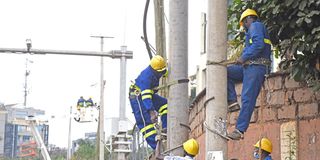Electricity peak demand bounces back in October

Kenya Power employees work on a power transformer along Waiyaki Way last month.
What you need to know:
- Data from the Energy and Petroleum Regulatory Authority shows that peak demand surpassed the pre-Covid levels in October , signalling economic recovery despite the threat from a second wave of the scourge.
- Kenya Power Managing Director Bernard Ngugi last month said the decision to relax the push for a renegotiation on power supply deals had been communicated to producers after demand recovered to the pre-Covid levels.
- The monopoly power distributor had written to the electricity suppliers seeking to declare wholesale power supply contracts null and void following a drop in demand in the wake of the global Covid-19 pandemic.
Electricity peak demand recovered to hit a new high this month ending the slow path to recovery after months of poor uptake this year.
Data from the Energy and Petroleum Regulatory Authority shows that peak demand surpassed the pre-Covid levels in October , signalling economic recovery despite the threat from a second wave of the scourge.
“The peak electricity demand now stands at 1,938 megawatts up from the 1,765 megawatts recorded at the onset of Covid-19 pandemic in April, an indicator that Kenya’s economy is on a recovery path,” Epra director general Pavel Oimeke wrote.
The country’s energy peak demand plunged to a record low of 1,765MW following a freeze on various economic sectors such as hotels, schools and some industries to curb pread of coronavirus.
Financial constraints
The fall pushed Kenya Power into further financial constraints as it was left with power it could not sell but which had to be paid for under the ‘take-or-pay’ clauses in the power purchase agreements it had signed with the generators.
Recovery in demand has since driven Kenya Power to withdraw its push for a force majeure on electricity supplies, which was opposed by a section of the electricity suppliers.
Kenya Power Managing Director Bernard Ngugi last month said the decision to relax the push for a renegotiation on power supply deals had been communicated to producers after demand recovered to the pre-Covid levels.
“We have written to all the electricity suppliers that from August 2020, demand is back to normal and we will be paying as per the power purchase agreement. The only period where the force majeure will apply is between March and August which is when we had depressed demand driven by the pandemic,” Mr Ngugi said.
Demand for electricity dropped 15.3 percent to 645.29 million kilowatt-hours (kWh) in April (the first full month of Covid-19 restrictions), leaving Kenya Power with nearly 203 million kWh of power that was generated.
Reduced electricity consumption
The monopoly power distributor had written to the electricity suppliers seeking to declare wholesale power supply contracts null and void following a drop in demand in the wake of the global Covid-19 pandemic.
Kenya Power, which recently issued its third profit warning in a row, citing reduced electricity consumption, had faced a major pushback from six independent power producers (IPPs) who protested the move to invoke the force majeure, arguing that the risk of a decline in the national demand for electricity under the PPAs is borne by Kenya Power and not IPPs.
Kenya currently has an installed capacity of 2,766MW making the peak demand which has hardly hit 2,000MW still low and which leaves consumers with the burden to pay for power that has not been used .
Too much generated power has been a major bone of contention between Kenya Power and the sector regulator, which stands accused of allowing too many players in the sector and choking the distributor with excess power.





